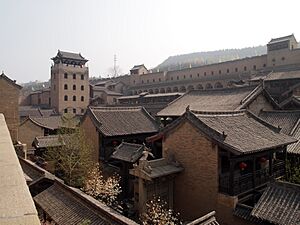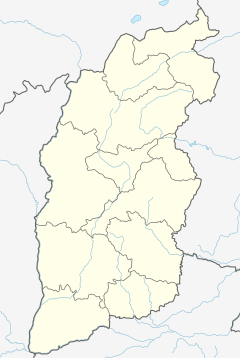Jincheng facts for kids
Quick facts for kids
Jincheng
晋城市
Tsincheng
|
|
|---|---|
|
Prefecture-level city
|
|

The Tower of Rivers and Mountains overlooking the House of the Huangcheng Chancellor
|
|

Location of Jincheng City jurisdiction in Shanxi
|
|
| Country | People's Republic of China |
| Province | Shanxi |
| County-level divisions | 6 |
| Municipal seat | Chengqu |
| Government | |
| • Type | Prefecture-level city |
| Area | |
| • Prefecture-level city | 9,490 km2 (3,660 sq mi) |
| • Urban | 143.00 km2 (55.21 sq mi) |
| • Districts | 2,164.0 km2 (835.5 sq mi) |
| Population | |
| • Prefecture-level city | 2,279,151 |
| • Density | 240.16/km2 (622.0/sq mi) |
| • Urban | 493,000 |
| • Urban density | 3,448/km2 (8,929/sq mi) |
| • Districts | 1,067,000 |
| GDP | |
| • Prefecture-level city | CN¥ 142.6 billion US$ 22.4 billion |
| • Per capita | CN¥ 65,122 US$ 10,420 |
| Time zone | UTC+8 (China Standard) |
| Postal code |
048000
|
| Area code(s) | 0356 |
| ISO 3166 code | CN-SX-05 |
| Licence plates | 晋E |
| Administrative division code | 140500 |
| Website | www.JCOnline.cn |
|
Cedrus Lagerstroemia indica |
|
| Jincheng | |||||||||
|---|---|---|---|---|---|---|---|---|---|
| Simplified Chinese | 晋城 | ||||||||
| Traditional Chinese | 晉城 | ||||||||
| Literal meaning | Jin City | ||||||||
|
|||||||||
Jincheng is a prefecture-level city situated in the southeast of Shanxi province, China. It shares its border with Henan province to the south and southeast. The city is recognized as an industrial hub, with coal mining being one of its key industries. The population of the entire city is estimated to be 2.2 million.
Due to the extensive coal industry in the region, Jincheng has gained notoriety for air pollution. However, the local government has recently made significant investments to address this issue. Efforts have been made to enhance the air quality in the city, such as tree planting, developing and maintaining vast parks and ecological reserves, shutting down or relocating some of the most polluting factories, and promoting the use of coalbed methane, which is a cleaner fuel source than coal.
History
Jincheng has a rich history dating back to the Warring States period. During this time, the land of Jinguo was divided and settled by Zhao, Wei, and Han. Later, the Late Jin monarch was settled in Qinshui County of Jincheng. The famous battle of Changping between Qin and Zhao took place in Gaoping City of Jincheng towards the end of the Warring States period. After the first emperor of Qin unified the six countries, China was divided into 36 shires, and most of Jincheng and Southeast Shanxi belonged to Shangdang Shire. Throughout the Han and Wei dynasties, Jincheng remained a part of Shangdang Shire and Pingyang Shire.
During the Sixteen States period, West Yan Murong Yong established Jianxing Shire in the southern region of Shangdang Shire, which marked the beginning of Jincheng becoming a Shire. Subsequently, the name of Jianxing Shire was changed several times, first to Jianzhou during the Northern Wei dynasty, then to Zezhou during the Sui dynasty, and finally, it was upgraded to Zezhoufu during the Qing dynasty. These administrative changes were essentially consistent with the five counties under the jurisdiction of Jincheng today. It was not until the Republic of China period that Yuan Shikai issued a policy to transform all Chinese states into counties.
Economy
Jincheng boasts abundant mineral resources, particularly coal. Coal-beds cover more than 56% of the total area, predominantly comprising anthracite, a high-quality coal with minimal impurities. The anthracite reserves in Jincheng account for over a quarter of China's total and half of Shanxi province's total. In addition, Jincheng has a substantial coal mine methane field, discovered in Qinshui county in 2001. The production of both anthracite and coal mine methane is mainly carried out by Jincheng Anthracite Mining Group.
Apart from its coal-related industries, Jincheng also houses a significant Foxconn manufacturing campus that produces fiber optic parts, with an annual output value of over 3 billion RMB.
Geography
Jincheng is situated in the southeastern corner of Shanxi province, covering an area of 9,490 square kilometers. It has 188,920 hectares of arable land.
Transportation
Jincheng is accessible via China National Highway 207 and the Taiyuan–Jiaozuo Railway. However, it does not have a commercial airport, with the nearest ones located in nearby cities such as Zhengzhou, Changzhi, and Luoyang.
Climate
Jincheng has a rather dry, monsoon-influenced humid continental climate (Köppen Dwa), with cold and very dry winters, and hot, humid summers. The monthly 24-hour average temperature ranges from −2.2 °C (28.0 °F) in January to 24.2 °C (75.6 °F) in July, and the annual mean is 11.83 °C (53.3 °F). Typifying the influence of the East Asian Monsoon, over two-thirds of the annual 576 millimetres (22.7 in) of precipitation occurs from June to September.
| Climate data for Jincheng, elevation 753 m (2,470 ft), (1991–2020 normals, extremes 1981–2010) | |||||||||||||
|---|---|---|---|---|---|---|---|---|---|---|---|---|---|
| Month | Jan | Feb | Mar | Apr | May | Jun | Jul | Aug | Sep | Oct | Nov | Dec | Year |
| Record high °C (°F) | 19.1 (66.4) |
24.2 (75.6) |
28.2 (82.8) |
36.9 (98.4) |
36.5 (97.7) |
38.6 (101.5) |
38.6 (101.5) |
35.8 (96.4) |
36.6 (97.9) |
32.6 (90.7) |
26.6 (79.9) |
18.7 (65.7) |
38.6 (101.5) |
| Mean daily maximum °C (°F) | 4.0 (39.2) |
7.4 (45.3) |
13.3 (55.9) |
20.2 (68.4) |
25.1 (77.2) |
28.8 (83.8) |
29.5 (85.1) |
28.1 (82.6) |
24.0 (75.2) |
18.6 (65.5) |
11.8 (53.2) |
5.7 (42.3) |
18.0 (64.5) |
| Daily mean °C (°F) | −1.9 (28.6) |
1.3 (34.3) |
6.9 (44.4) |
13.5 (56.3) |
18.9 (66.0) |
23.0 (73.4) |
24.5 (76.1) |
23.1 (73.6) |
18.6 (65.5) |
12.7 (54.9) |
5.9 (42.6) |
0.0 (32.0) |
12.2 (54.0) |
| Mean daily minimum °C (°F) | −6.4 (20.5) |
−3.3 (26.1) |
1.7 (35.1) |
7.8 (46.0) |
13.2 (55.8) |
17.7 (63.9) |
20.5 (68.9) |
19.4 (66.9) |
14.4 (57.9) |
8.0 (46.4) |
1.3 (34.3) |
−4.4 (24.1) |
7.5 (45.5) |
| Record low °C (°F) | −17.4 (0.7) |
−17.4 (0.7) |
−10.1 (13.8) |
−3.6 (25.5) |
2.9 (37.2) |
10.1 (50.2) |
13.5 (56.3) |
11.0 (51.8) |
4.4 (39.9) |
−3.6 (25.5) |
−12.6 (9.3) |
−16.6 (2.1) |
−17.4 (0.7) |
| Average precipitation mm (inches) | 9.0 (0.35) |
12.4 (0.49) |
16.5 (0.65) |
36.7 (1.44) |
49.0 (1.93) |
67.9 (2.67) |
136.6 (5.38) |
120.7 (4.75) |
71.4 (2.81) |
36.4 (1.43) |
20.6 (0.81) |
5.6 (0.22) |
582.8 (22.93) |
| Average precipitation days (≥ 0.1 mm) | 4.0 | 4.5 | 5.3 | 6.3 | 7.6 | 8.9 | 12.4 | 11.6 | 10.0 | 7.0 | 5.0 | 3.4 | 86 |
| Average snowy days | 5.0 | 4.9 | 2.7 | 0.4 | 0 | 0 | 0 | 0 | 0 | 0.1 | 2.0 | 4.0 | 19.1 |
| Average relative humidity (%) | 52 | 55 | 52 | 54 | 55 | 60 | 74 | 76 | 71 | 64 | 58 | 51 | 60 |
| Mean monthly sunshine hours | 169.4 | 168.2 | 201.2 | 228.9 | 246.6 | 226.6 | 201.5 | 194.8 | 166.8 | 176.2 | 169.8 | 175.9 | 2,325.9 |
| Percent possible sunshine | 54 | 54 | 54 | 58 | 57 | 52 | 46 | 47 | 45 | 51 | 56 | 58 | 53 |
| Source: China Meteorological Administration | |||||||||||||
Administrative divisions
| Map | |||||
|---|---|---|---|---|---|

Cheng
Zezhou
County Qinshui
County Yangcheng
County Lingchuan
County Gaoping
(city) |
|||||
| Name | Hanzi | Hanyu Pinyin | Population (2003 est.) |
Area (km2) | Density (/km2) |
| Cheng District | 城区 | Chéngqū | 280,000 | 141 | 1,986 |
| Gaoping City | 高平市 | Gāopíng Shì | 480,000 | 946 | 507 |
| Zezhou County | 泽州县 | Zézhōu Xiàn | 510,000 | 2,023 | 252 |
| Qinshui County | 沁水县 | Qìnshuǐ Xiàn | 210,000 | 2,655 | 79 |
| Yangcheng County | 阳城县 | Yángchéng Xiàn | 390,000 | 1,968 | 198 |
| Lingchuan County | 陵川县 | Língchuān Xiàn | 250,000 | 1,751 | 143 |
See also
 In Spanish: Jincheng para niños
In Spanish: Jincheng para niños


